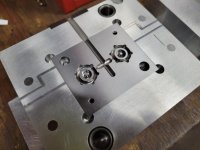Hi Pressman:
I've noticed a few posters recommend leaving the inserts proud so they will seal when the press closes.
Normally with a conventional sprue and runner system originating from the center top of the mold and going through the hotside plate, I would have no objection to this strategy.
But you have stated that you are spruing and gating from the side, and the mold plates you showed in one of your earlier posts shows that clearly.
That changes everything!
If you want to avoid flashing of the runner system, you MUST seal on the mold base as well as the inserts.
Flashing of the runner system is undesirable for a couple of reasons:
First, it leaves flash and trash all over the mold base and that flash will beat the shit out of the mold very quickly:
This was drool from the sprue, not flash but the effect is the same:

Second, it prevents the building of injection pressure early in the injection cycle until you can plug the gap with congealed plastic, so it screws up the injection.
Third, if you make it bad enough it represents a hazard to the press operator.
Molten plastic squirting out the parting line is bad...plastic burns are particularly nasty.
So be careful with how much you leave the inserts proud on a build like this one.
Ideally everything is dead nuts flat and stays that way as the mold is cycled.
Unfortunately in real life, everything squashes and distorts...you are trying to get a sense of how much and compensate accordingly.
The clamping pressure squashes things a bit.
The injection pressure make the mold want to inflate like a balloon.
The platens are not perfectly flat and don't come together with perfect parallelism.
So don't get too carried away making the inserts proud on a side sprued mold.
0.001" per side is the maximum I'd consider, and only if I have no way of making the finish and flatness on the pocket floors nice, and only if I don't have a surface grinder to make the inserts properly flat.
You will be left with a 0.002" gap...OK if you shoot polycarbonate but not OK if you shoot nylon.
Normally with a grinder and a way of making good pockets, I'd aim for a perfect match (or maybe 0.0002" proud), and typically, if the mold couldn't be made to seal I'd make the jacks proud a thou or so to bend the B plate a bit, and if it was bad, or the press was crappy or the mold was huge, I'd crown the top and bottom plates a twitch.
Note this is most true for the side sprued mold...a conventionally sprued mold with a center sprue bushing is far more forgiving so long as everything along the flow path is contained within the inserts.
Cheers
Marcus
Implant Mechanix • Design & Innovation > HOME
Vancouver Wire EDM -- Wire EDM Machining


